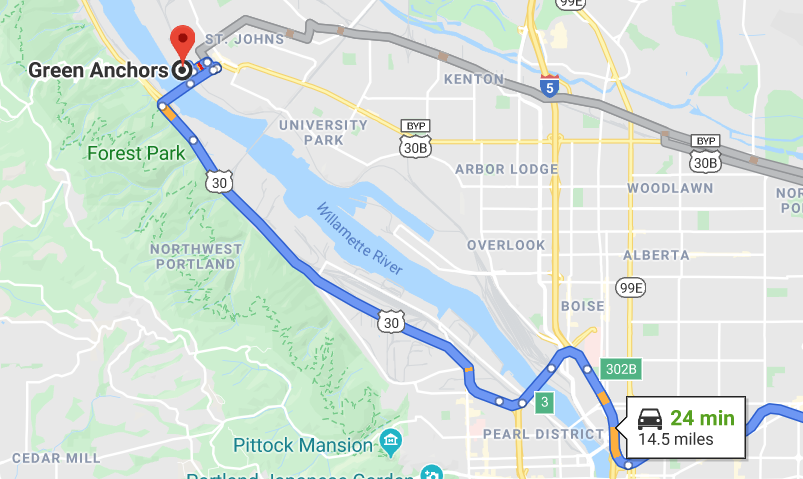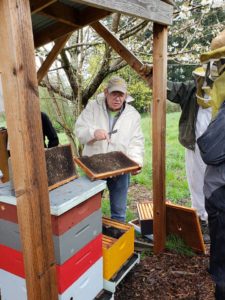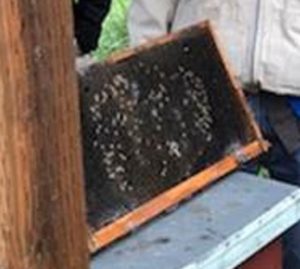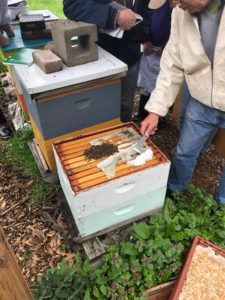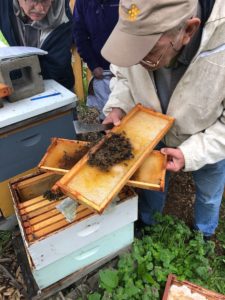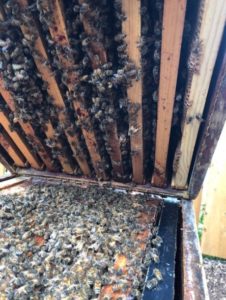Don’t miss the news about our apiary move.
Apiary Move
The club apiary is on the move. We have thoroughly enjoyed the partnership we’ve had with Zenger farm since the very founding of this club. Unfortunately, with a number of break-ins and burglaries over the past few years it’s just not a secure place for our bees anymore. It is with great sadness we must say goodbye to our Zenger hosts and move the apiary to a new location. Our last day at Zenger will be Dec 19, 2019. Below is the text of the announcement sent to the board members, which explains the situation.
To our 2019 and 2020 Board Members,
As many of you may or may not know, the PUB apiary shed was broken into, again. Thank goodness that the bees were not disturbed this time. Not too much is missing, all of our smoker lighters were taken, possibly some bee suits. Someone attempted to burn some frames and a few foundations were broken. A police report was filed and Zenger was notified. Because a lock was broken and a structure was entered it is called “Burglary”. The officer who came to file the report felt that because we were so close to the Spring Water Trail, this was most likely a crime of opportunity. He also shared that these types of crimes are becoming more frequent, and that with the location of our shed and apiary, we are very likely to be known and targeted repeatedly. Unfortunately, Zenger representatives were contacted on Sunday, but never followed up with us. Zenger lack of engagement has been an ongoing problem.
With this in mind Cheryl and Mandy began to look for an alternate apiary site. Another CSA farm was contacted, but it was too small to support our numbers. There were not any true farms outside of Sauvie Island that could support our needs, and we felt that at this time, Sauvie Island was a little too far to drive. Mandy reached out to one of the PUB founders, Tim Wessels, and he offered to take our apiary into his. He is located in north Portland, right next to Cathedral Park, by the St. Johns Bridge. Both Mandy and Cheryl went out to look at the site, and it does seem ideal. Not only is the spot beautiful, but the apiary and grounds are well maintained, there are structures for the club to meet under in case of rain, and there are two well-kept sheds. There is also plenty of forage for the bees. The name of the area that the apiary is located is Green Anchors. Mandy and Cheryl think that this will be a very positive move for PUB, and we would like any feedback, both in support as well as in opposition. We really want to hear what you think.
We are on a quick turn-around as right now the weather and time of year are ideal for moving the bees, so if we don’t hear from you in a few days, we will assume that you have no strongly opposing views or concerns.
Thank you for your support, and we look forward to hearing any feedback.
Green Anchors is located at 8940 N Bradford St, Portland, OR 97203
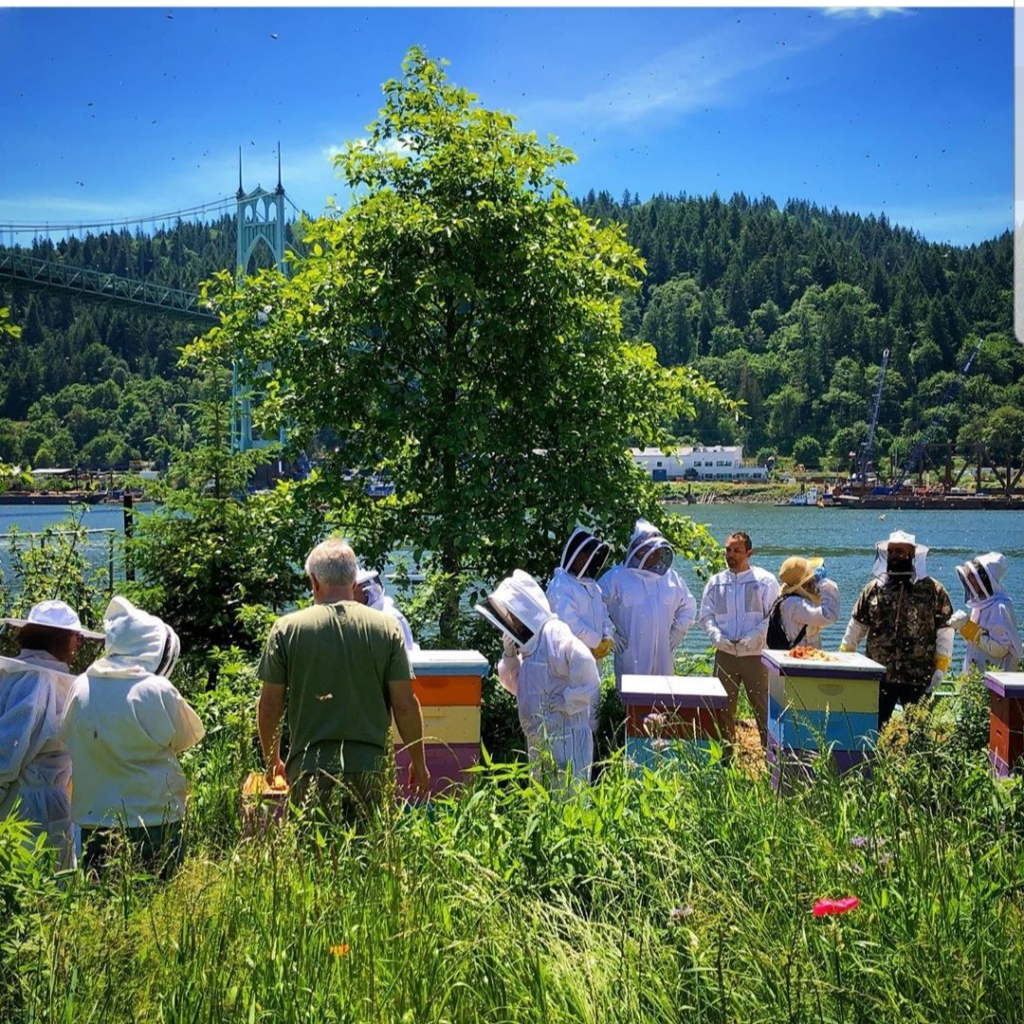
January 2019 – Club Updates
Thank you to everyone that attended our January meeting! Though the meeting space was tight, I think that if our bees could have seen us they would have have enjoyed seeing us beekeepers crammed together in harmonious learning.
Like swarming bees, we are looking for a new place for PUB to call “home.” Our previous two meetings were held at the Lucky Labrador on SE Hawthorne, but alas it was too crowded. Our February meeting will be held at the Lucky Labrador’s NW PDX location at 1945 NW Quimby which has space for 100. In the meantime, we will continue to search.
A new year brings new guidelines for Oregon beekeepers. Cheryl Wright, our club treasurer and student in the OSU Master Beekeeper program explained the new best practices, which can be downloaded for free here. These guidelines were developed to aid cities throughout Oregon to have a better understanding of the benefits of residential beekeeping and that honey bees can be kept in a nuisance free manner. The comprehensive booklet also serves as a common sense guide for how to keep our bees in ways that won’t upset or bother our neighbors. Additionally, the Oregon State Beekeepers Association has designated persons to aid in conflict resolution should the need arise.
We discussed our finances for 2018, which showed that the club had lower revenues but also lower expenses for the year. Your membership dollars are important for the ongoing operations of the club: business registration, taxes, rent, apiary expenses, website/hosting fees and our PO Box for example. We intend to give quarterly updates moving forward as requested by our members who participated in the member survey which can be accessed here.
Glen Andresen from Bridgetown Bees shared trivia and his What’s in Bloom report for January. Glen has been a staple for PUB meetings for years and if you are like me, you appreciate the plant knowledge that he contributes!
Our new board of directors was voted in and here are the results: President – Mandy Shaw, Vice President – Simone Miller, Education Director – Rebekah Golden, Communications Director – Forrest Stotts, Treasurer/Secretary – Cheryl Wright, Librarian – Lauren Smith, and Member at Large – Emma Egstad.
Volunteers who generously donate their time, talents, and resources keep PUB alive as an organization. If you are interested in volunteering or becoming more active in the club, please contact any of us!
October 2018 Member Meeting
It is hard to believe that the bee season is winding down and the window of opportunities to work with our bees is closing. Knowing what to look for and when to take action can be tricky, but fortunately we have great resources available to us including Dr. Dewey Caron who presented his October apairy plan and his talk on FAT WINTER BEES. His presentation is included below.
Glen Andresen kicked off our meeting with the monthly pollen and nectar report complete with some much enjoyed Oregon triva!
I also shared a recent experience that I had involving a cut out of a feral colony that had what I suspected was small hive beetle. With the help from the OSU Bee Lab, we were able to positively identify them as SHB. You can read more about small hive beetles here. If you suspect that you have a colony with SHB, you can contact the bee lab for positive identification. They are extremely responsive and helpful! The current statement on SHB in Oregon is:
“Current climatic conditions may not be ideal for SHB overwintering, pupation, or establishment in most of Oregon, but future changes in climate, such as frequent mild winters, could aid in their establishment. Early detection and control of SHB will help keep or delay this pest from successfully establishing in Oregon. Use caution when purchasing package bees, established colonies, or queens from locations where SHB is well established. Also, monitor your colonies for small hive beetles during summer and fall if you regularly transport your bees across state lines for pollination, especially to California for almond pollination.”
Thank you to all who attended – I look forward to seeing you again in November!
September 2018 Member Meeting
With summer beekeeping coming to a close, now is a critical time for our colonies as we help transition them into fall. This month’s member meeting was not only well attended by our regulars, we also welcomed several “newbees” to the group. Thank you to everyone who was able to attend!
Glen Andresen of Bridgetown Bees kicked off the evenings program with his pollen and nectar report. Surprisingly, there is a lot in bloom (just not many trees)!
Dr. Dewey Caron gave an informative talk about what is happening in our bee colonies this month: brooding down, and raising fat winter bees. If your colonies are light, now is the time to feed! Pollen supplements will help September nurse bees raise fat winter bees. Now is also the time for mite counts! You can participate in the Mite-a-Thon by submitting your mite counts Sept 8 – 15 to mitecheck.com. The data collected gives a snapshot of mite infestations in a specific time frame. The mite-a-thon is open to anyone and their mites (ew!).
Linda Zahl shared her new found love for native bees and gave an introduction to the Oregon Bee Atlas training! Portland Urban Beekeepers is working to arrange a Bee Atlas training for our members – stay tuned for updates!
Emily Parker from Bee & Bloom gave a very impressive talk about bees around the world. Her presentation was loaded with captivating imagery, and bee facts that we usually don’t hear about!
Enjoy your September, and we’ll see you again in October!
August 2018 Member Meeting
Thank you to all who attended the meeting last night! We had a full line up of interesting presentations – here’s a recap:
I was excited to share the story of how PUB was selected to participate in a FaceBook Adventures campaign that highlighted some of the eclectic clubs that Portland has to offer. You can watch the video here. You will be happy to know that our bees were on their best beehavior for the director & production team and we had a wonderful time representing our club.
Glen Andresen from Bridgetown Bees gave his monthly Pollen & Nectar report which always includes important and timely information for us beekeepers!
Emma Egstad, our member at large and co-owner of Bee & Bloom shared tips on Honey & Wax Processing and included interesting points on the history & science of honey and wax.
Robert Leger shared the second portion of his yellow jacket series, this time focusing on yellow jacket nest abatement. Yellow jackets can have a tremendous and negative impact on the honey bee population. Knowing how to approach and destroy a yellow jacket nest can save vulnerable hives from being invaded.
Dewey Caron had several show-and-tell items to share and gave very practical advice on how we can address varroa mites now, before our bees head into fall and winter. He also mentioned the following resources:
OSU Extension Service recommendations for protecting honey bees from yellow jackets.
We look forward to seeing you next month!
July 2018 Member Meeting
Thank you for everyone who braved the heat to join us this past Wednesday for our monthly membership meeting! For those of you who were unable to attend or need a recap, here are the highlights:
Glen Andresen of Bridgetown Bees gave us our monthly Pollen & Nectar Report, along with some Portland trivia! Did you know that Glen also hosts a radio show about gardening called The Dirtbag? You can listen to it on KBOO Radio.
As we turn the corner from swarm season & nectar flow to summer dearth and preparation for autumn, we also need to be considering Varroa management.
This month our featured speaker was Dr. Brandon Hopkins from WSU. He shared his research and data on using a forced brood break to enhance Varroa control. If you are treatment free, working towards treatment free, or are seeking ways to use less chemical treatments this is an excellent method! You can purchase the queen cages used in this research here (note – it is important that what ever cage is used for this method, the workers are still able to access the queen in order to spread her pheromones through the hive, otherwise you may be left with a colony trying to requeen itself). Other considerations for this method include: Does the colony have the population to support a brood break? Time of year – it is not recommended to use this method late in the summer. Before or just after the nectar flow is ideal.
PUB members reported higher levels of loss than the rest of the state (according to the results of the PNW Honeybee Survey). It is important that we be proactive in Varroa monitoring and control. If you are unsure about how to collect mite samples from your hive, please contact us to get connected with a Bee Buddy, or come to one of our apiary work parties at Zenger Farm on the 1st and 3rd Sunday of each month from 10-12. We will teach you how to collect mite samples!
Until next time, happy beekeeping!
June 2018 Member Meeting
Thanks to everyone that joined us for our June member meeting!
This month’s meeting featured Glen Andresen’s pollen and nectar report which can be found here. We also heard from our treasurer, Cheryl Wright who shared her experiences with the Oregon Master Beekeeping program. If you are interested in learning more about OMB, you can visit their website here. If you wish to join the program, now is the time to get on the 2019 wait list!
We also had the pleasure of listening and learning from honorary PUB member, Dr. Dewey Caron. He shared his results and insights from the PNW loss report which indicated that PUB participants had a higher loss rate than the overall Oregon loss. He provided guidance on IMP and moving towards treatment free beekeeping methods. You can view his presentation below:
Until next time, happy beekeeping!
Dead Colony Forensics
(By Dewey M. Caron)
About a dozen brave individuals gathered at the Zenger apiary colonies Sunday April 15th, during a steady Oregon liquid “sunshine” for dead colony forensics with Dewey.
Temperature was low 50s, with only a couple foraging bees venturing forth from 4 of 8 colonies. We hefted boxes and looked at two deadouts and in the top and between brood boxes of a very strong colony (but did not lift any frames).
Bees die overwinter for a number of reasons. By doing a dead colony autopsy we seek to determine what might have been the likely reason for non-survivorship. Understanding the why might help us avoid a repeat this next winter. The first deadout we looked at proved to be a tough diagnosis.
The colony was a mid-May nuc donation from Beetanical apiaries of Lane Co. Hive had a standard and a shallow. The shallow frames were quite full (>3/4ths of cells) with capped honey. The shallow was lifted off and placed on upside-down cover. There were dead brood remains on three frames of the lower standard box plus a small (<2000) number of dead adult bees on the screen bottom board and outside the entrance.
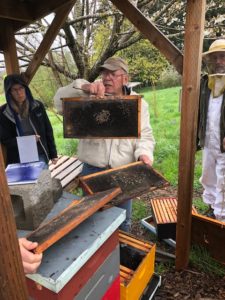
Two adjacent frames had widely scattered capped cells extending in an oval covering over 1/3 of the middle of the frames; there was a fist-sized patch of compact capped brood but it was not contiguous with the scattered brood of the other two frames. There was no evidence of a dead cluster but a considerable number of cells of stored pollen on 5 frames. Ample mold was evident in pollen cells and as a powdery grayish mold on surface of cells. Colony was sampled for mites with a sugar roll in September and had only 2 mites (<1%). It was NOT treated for mites as it was a non-treatment control. Colony was alive in a mid-October inspection.
Photo of the three frames with brood shows the frame with a patch of compact brood (held in my right hand) and two frames with very scattered brood (one in my left hand and the third on top of adjacent hive; this frame is shown isolated in photo below). Full super on ground.
So what can we diagnose? Lots of honey and pollen stores so we can likely rule out starvation. Small number of dead bee bodies suggests a small colony but if we would believe death from a too-small population of adults, there should have been evidence of a cluster with bees within cells and dead bee remains on the frame(s). There wasn’t.
Thus our best guess is a colony that had a BEE PMS condition. The scattered brood remains on both sides of the two frames suggests this –a spotty (snot) brood situation MIGHT have been diagnosed in the October examination, but this requires a close examination of the brood; we might have noticed evidence to too few adult bees to cover the brood – both are subtle clues. The fist-sized brood area, on a frame one frame over from the other two frames with scattered brood, might have been bees trying to escape the high mite numbers and their unhealthy brood of the 2 frames with scattered cells. Adult bees were likely dying prematurely and abandoning their (unhealthy) hive, thus the reason we saw only a smallish number of adult dead bees. The colony likely failed to rear sufficient fat, fall bees. The colony likely died within a month after the last October inspection, probably from a virus epidemic related to the mite infestation. NOTE: The September mite sample is misleading/confusing (we would expect it to have been higher); if an additional sample was taken it would perhaps have been higher?
The second deadout was a more standard autopsy. Hive was a spring split, that struggled all season. It had 2 shallows. Colony had a 19 mite count (6%+) in September and was treated with 2 formic pads between the two boxes. It was alive in March (this spring) but noted as small. It was fed dry sugar on paper (some still remaining) and provided with a frame of sugar candy.
Opening the top and removing moisture trap, (all Zenger hives had moisture quilt traps at top) showed a dead cluster of adult bees on 3 frames in top box at top of the box extending down about ½ way on the 3 frames (see photos; in photo right hive tool is showing the remaining dry sugar on paper; quilt trap with wood shaving lower right). The adult bees were black and showed excessive moisture; there were many maggots (scavenger fly) feeding on the dead bees. There was capped brood in compact pattern within the cluster. Dead adult population was small (perhaps 10,000 bees). There was NO capped honey in any of the frames of either box. Lower box was empty. There were some dead bees on solid bottom board. There was little mold.
So what was diagnosis? The dead cluster is characteristic of a colony that overwintered the tough months (Dec-Feb) and moisture of adult bees, maggots and little mold suggests recent death . The compact brood shows the colony was starting to expand in the spring (flight was noted in March). Although dry sugar (as candy and crystal sugar) was given as emergency feed (hefting would have revealed lack of enough stores) turned out to not be enough — colony likely starved. Bee cluster too small to generate enough heat to make slurry out of dry sugar or candy so bees couldn’t use it. Photo left shows one of three frames. We see “bee butts” under the dead cluster and compact capped brood.
All frames, except one with high number of drone cells, could be reused. Brush off dead cluster and form bottom boards. If inclined wash mold with bleach or vinegar solution.
We also looked at a hive with two very full boxes of bees.
The Vivaldi box had dry sugar and the burlap was quite wet on top but dry and distinctly warm below. Hefting indicated honey present – probably enough to cover two frames, the minimum that should be present. Then to determine if they might be rearing queens, the two (standard-size) boxes were split and the top box (and top quilt box) was angled up to look at the bottom of the frames of the top box. No queen cells were seen but there were several queen cups. Splitting was discussed – the next nice day a 3 frame split can be taken from this hive.
April Member Meeting
Spring is here and the apiary to-do list is ready to go! We had a full house at this months meeting and are grateful for everyone who came. BeSpoke Bee Supply donated a swarm box and PUB member Steve Niles shared milkweed seeds for our raffle.
Glen Andresen kicked off our meeting with the monthly pollen and nectar report complete with some much enjoyed Oregon triva!
Dewey Caron returned from his winter travels and shared tips for what to do in the apiary this month, as well as an update on the PNW Honeybee Survey. The success of the survey is dependent on participation! You can take the survey by clicking here. We were also pleased to present Dewey with a lifetime honorary membership to Portland Urban Beekeepers!
Yellow jackets are a problematic and sometimes devastating visitor in our bee yards. Being ahead of the yellow jackets can give your bees a much needed break from these predators as bee colonies wind down brood and honey production for the season. Robert Leger gave us some valuable identification tips, as well as insight on the yellow jacket life cycle. He gave us strategies for baiting and catching queens (keeps some rocks handy!) and how to deal with the workers. Did you know that yellow jackets orient themselves to the food source? You can check out Robert’s presentation here: The Yellow Jacket-free Home
The beekeeping community has been buzzing about the new Best Practices in Residential Beekeeping guidelines. Mike Rodia shared the document with us and gave an overview of why this is so important. “The best practices guidelines would make it possible to use existing local nuisance ordinances instead of new legal restrictions for managing conflicts that arise from beekeeping in residential areas.”
Just like generally accepted accounting principles (GAAP) were developed as a means to use common sense widely & recognized principles in accounting, these guidelines for residential beekeeping are put into place so that beekeepers, our neighbors, and local/state government have some basic principles to refer to that demonstrate that we are keeping our bees in nuisance free manner.
If you live in Portland, you will still need to obtain a permit for keeping bees. More information on that can be found here. If you are unsure if your city of residence requires permits or has limitations on residential beekeeping, please check your city government website.
Until next time beekeepers, bee well!

